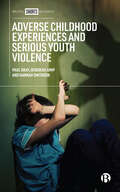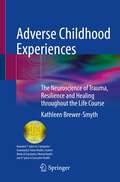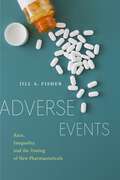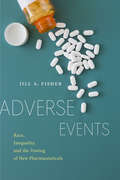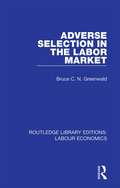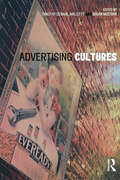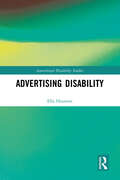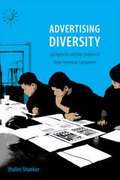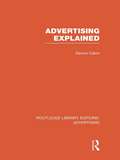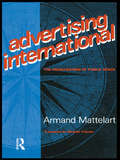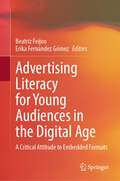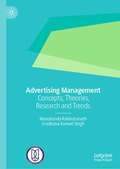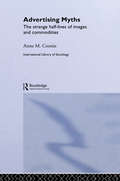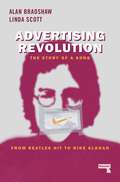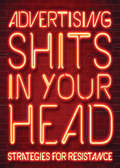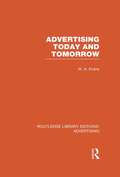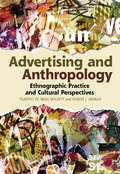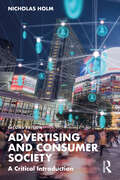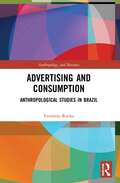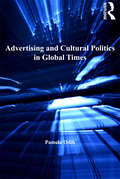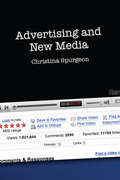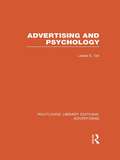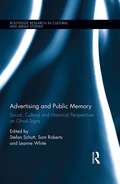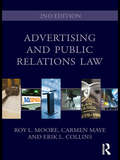- Table View
- List View
Adverse Childhood Experiences and Serious Youth Violence
by Paul Gray Deborah Jump Hannah SmithsonWhereas crime more generally has fallen over the last 20 years, levels of serious youth violence remain high. This book presents innovative research into the complex relationship between adverse childhood experiences and serious youth violence. While the implementation of trauma-informed approaches to working with adolescents in the justice system is becoming common practice, there remains a dearth of research into the efficacy of such approaches. Foregrounding young people’s voices, this book explores the theoretical underpinnings of trauma and the manifestations of childhood adversity. The authors conclude by advocating for a more psychosocial approach to trauma-informed policy and practice within the youth justice system.
Adverse Childhood Experiences: The Neuroscience of Trauma, Resilience and Healing throughout the Life Course
by Kathleen Brewer-SmythThe entire world is in crisis with adverse childhood experiences (ACEs) and other lifetime trauma at an all-time high. This book is a valuable resource to promote optimal brain function for everyone, but especially for survivors of trauma who are particularly at risk throughout the life course. It is critical for healthcare providers, schoolteachers and administration, public safety professionals, foster and adoptive parents, employers and loved ones to understand the potential life-long consequences that ACEs can have in the lives of survivors. This book describes the complexities behind why behaviors occur if hurt people hurt themselves and others. The first half of this book addresses what can go wrong in the brain and body after trauma that potentially leads to life-long poor bio-behavioral health outcomes. The second half of this book addresses how the life-long poor bio-behavioral health outcomes can be prevented, mitigated or potentially reversed. This book is necessary for everyone who is interested in optimizing brain function, especially survivors of ACEs and other trauma throughout the life course who are at greater risk. The major focus of the book is on how to prevent long-term negative consequences of trauma and how to restore the brain, body, behavior and emotions.
Adverse Events: Race, Inequality, and the Testing of New Pharmaceuticals (Anthropologies of American Medicine: Culture, Power, and Practice #9)
by Jill A. FisherWinner, 2022 Donald W. Light Award for Applied Medical Sociology, given by the Medical Sociology Section of the American Sociological AssociationWinner, 2021 Robert K. Merton Book Award, given by the Science, Knowledge, and Technology Section of the American Sociological Association2021 Outstanding Academic Title, Choice MagazineExplores the social inequality of clinical drug testing and its effects on scientific resultsImagine that you volunteer for the clinical trial of an experimental drug. The only direct benefit of participating is that you will receive up to $5,175. You must spend twenty nights literally locked in a research facility. You will be told what to eat, when to eat, and when to sleep. You will share a bedroom with several strangers. Who are you, and why would you choose to take part in this kind of study? This book explores the hidden world of pharmaceutical testing on healthy volunteers. Drawing on two years of fieldwork in clinics across the country and 268 interviews with participants and staff, it illustrates how decisions to take part in such studies are often influenced by poverty and lack of employment opportunities. It shows that healthy participants are typically recruited from African American and Latino/a communities, and that they are often serial participants, who obtain a significant portion of their income from these trials. This book reveals not only how social inequality fundamentally shapes these drug trials, but it also depicts the important validity concerns inherent in this mode of testing new pharmaceuticals. These highly controlled studies bear little resemblance to real-world conditions, and everyone involved is incentivized to game the system, ultimately making new drugs appear safer than they really are. Adverse Events provides an unprecedented view of the intersection of racial inequalities with pharmaceutical testing, signaling the dangers of this research enterprise to both social justice and public health.
Adverse Events: Race, Inequality, and the Testing of New Pharmaceuticals (Anthropologies of American Medicine: Culture, Power, and Practice)
by Jill A. FisherExplores the social inequality of clinical drug testing and its effects on scientific resultsImagine that you volunteer for the clinical trial of an experimental drug. The only direct benefit of participating is that you will receive up to $5,175. You must spend twenty nights literally locked in a research facility. You will be told what to eat, when to eat, and when to sleep. You will share a bedroom with several strangers. Who are you, and why would you choose to take part in this kind of study? This book explores the hidden world of pharmaceutical testing on healthy volunteers. Drawing on two years of fieldwork in clinics across the country and 268 interviews with participants and staff, it illustrates how decisions to take part in such studies are often influenced by poverty and lack of employment opportunities. It shows that healthy participants are typically recruited from African American and Latino/a communities, and that they are often serial participants, who obtain a significant portion of their income from these trials. This book reveals not only how social inequality fundamentally shapes these drug trials, but it also depicts the important validity concerns inherent in this mode of testing new pharmaceuticals. These highly controlled studies bear little resemblance to real-world conditions, and everyone involved is incentivized to game the system, ultimately making new drugs appear safer than they really are. Adverse Events provides an unprecedented view of the intersection of racial inequalities with pharmaceutical testing, signaling the dangers of this research enterprise to both social justice and public health.
Adverse Selection in the Labor Market (Routledge Library Editions: Labour Economics #7)
by Bruce C. GreenwaldFirst published in 1979. This thesis describes the theoretical impact on labour markets of a process of adverse selection similar to that described in outline by George Arthur Akerlof. It concerns the information conveyed to potential employers by the fact that any new worker, except for one just entering the labour force, has either left or is prepared to leave his latest Job. If an employer is able to identify his good workers more accurately than the market at large and is generally successful in retaining them, then the group of workers leaving him will contain a disproportionately small number of good ones. For similar reasons this pool should also contain an unusually large number of bad workers who have been either flied or induced to quit. Thus, workers who change jobs should on average be less able ones. Since the market failures that result have potentially significant consequences in the labour market, this study is devoted to examining their influence on the structure of wages and job tenure, and on the operation and efficiency of labour markets. This title will be of great interest to students of economics and business studies.
Advertising A New Approach: A New Approach (Routledge Library Editions: Advertising)
by Walter TaplinWalter Taplin here presents the first fruits of his exhaustive enquiry into the causes of this massive feature of contemporary life. Advertising has deeper and more interesting sources than the mere desire of manufacturers to secure markets, or of high-pressure salesmen to secure commissions. Taplin explores the nature of human wants, examines the functions and limitations of information, and distinguishes the good from the bad in the arts of persuasion. His approach to the subject is indeed a new one, and of the greatest value to all who wish to understand one of the most powerful forces of the day. First published in 1960.
Advertising Cultures
by Brian Moeran Timothy DeWaal MalefytThrough its artful engagement with consumers, advertising subtly shapes our everyday worlds. It plays upon powerful emotions -- envy, fear, lust and ambition. But the industry itself is far more subtle and complex than many people might assume. Through an innovative mix of business strategy and cultural theory, this pioneering book provides a behind-the-scenes analysis of the link between advertising and larger cultural forces, as well as a rare look into the workings of agencies themselves. How do advertisements endeavour to capture real life? How do advertising agencies think of their audience: the consumer and their corporate client? What issues do agencies have to consider when using an advertisement in a range of different countries? What specific methods are used to persuade us not only to buy but to remain loyal to a product? How do advertisers fan consumer desire? An incisive understanding of human behaviour is at the core of all these questions and is what unites advertisers and anthropologists in their work. While this link may come as a surprise to those who consider the former to be firmly rooted in commerce and the latter in culture, this book clearly shows that these two fields share a remarkable number of convergences. From constructing a Japaneseness that appeals to two very different Western audiences, to tracking advertising changes in the post World War II period, to considering how people can be influenced by language and symbols, Advertising Cultures is an indispensable guide to the production of images and to consumer behaviour for practitioners and students alike.
Advertising Disability (Autocritical Disability Studies)
by Ella HoustonAdvertising Disability invites Cultural Disability Studies to consider how advertising, as one of the most ubiquitous forms of popular culture, shapes attitudes towards disability. The research presented in the book provides a much-needed examination of the ways in which disability and mental health issues are depicted in different types of advertising, including charity 'sadvertisements', direct-to-consumer pharmaceutical advertisements and 'pro-diversity' brand campaigns. Textual analyses of advertisements from the eighteenth century onwards reveal how advertising reinforces barriers facing disabled people, such as stigmatising attitudes, ableist beauty 'ideals', inclusionism and the unstable crutch of charity. As well as investigating how socio-cultural meanings associated with disability are influenced by multimodal forms of communication in advertising, insights from empirical research conducted with disabled women in the United Kingdom and the United States are provided. Moving beyond traditional textual approaches to analysing cultural representations, the book emphasises how disabled people and activists develop counternarratives informed by their personal experiences of disability, challenging ableist messages promoted by advertisements. From start to finish, activist concepts developed by the Disabled People's Movement and individuals' embodied knowledge surrounding disability, impairments and mental health issues inform critiques of advertisements.Its critically informed approach to analysing portrayals of disability is relevant to advertisers, scholars and students in advertising studies and media studies who are interested in portraying diversity in marketing and promotional materials as well as scholars and students of disability studies and sociology more broadly.
Advertising Diversity: Ad Agencies and the Creation of Asian American Consumers
by Shalini ShankarIn Advertising Diversity Shalini Shankar explores how racial and ethnic differences are created and commodified through advertisements, marketing, and public relations. Drawing from periods of fieldwork she conducted over four years at Asian American ad agencies in New York, San Francisco, and Los Angeles, Shankar illustrates the day-to-day process of creating and producing broadcast and internet advertisements. She examines the adaptation of general market brand identities for Asian American audiences, the ways ad executives make Asian cultural and linguistic concepts accessible to their clients, and the differences between casting Asian Americans in ads for general and multicultural markets. Shankar argues that as a form of racialized communication, advertising shapes the political and social status of Asian Americans, transforming them from "model minorities" to "model consumers." Asian Americans became visible in the twenty-first century United States through a process Shankar calls "racial naturalization." Once seen as foreign, their framing as model consumers has legitimized their presence in the American popular culture landscape. By making the category of Asian American suitable for consumption, ad agencies shape and refine the population they aim to represent.
Advertising Explained: Advertising: Advertising Explained (Routledge Library Editions: Advertising)
by Dennis CatonThis work explains the various elements which go to the making of a successful advertising campaign – the planning, research and discussion – and gives some helpful information about advertising media, the creation of advertisements, about printing processes and mechanical production. It touches upon marketing and distribution and shows how these things must have a direct bearing on any well-framed advertising policy. The work of the Advertising Agency is fully described and there is some interesting advice about overseas advertising. Advertising Explained contains 27 illustrations, including a number of most useful diagrams and charts –invaluable for day-to-day reference. First published in 1949.
Advertising International: The Privatisation of Public Space (Comedia)
by Armand MattelartFirst published in 1991. Routledge is an imprint of Taylor & Francis, an informa company.
Advertising Literacy for Young Audiences in the Digital Age: A Critical Attitude to Embedded Formats
by Beatriz Feijoo Erika Fernández GómezThis book analyzes how children and adolescents aged between 10 and 17 engage with digital advertising and highlights the importance of promoting advertising literacy to help young audiences recognize advertising and distinguish it from other media content in the digital age. As the advertising sector evolves, incorporating new formats like branded content and influencer marketing, the frontiers between commercial content and regular media become blurred, posing a challenge for children and adolescents to discern persuasive intent in advertising and distinguish advertising from other media content. In this context, it is crucial to assess children and adolescents’ preparedness to navigate digital advertising effectively by understanding their level of advertising literacy. With a higher level of advertising literacy, young audiences can evaluate advertisements, considering factors such as product appeal, presentation, and relevance to their experiences, as well as grasp thepurpose behind advertising and the techniques employed. This contributed volume brings together empirical studies and literature reviews to present an overview of the current research on advertising literacy among boys and girls aged between 10 and 17 in different countries to help educators, policymakers, advertisers, and society at large collaborate in nurturing responsible, informed, and ethically conscious digital citizens. Advertising Literacy for Young Audiences in the Digital Age: A Critical Attitude to Embedded Formats will be of interest to researchers working with media education, media sociology and childhood and adolescence studies. It will also help educators and policymakers develop better strategies to prepare children and adolescents to navigate digital advertising effectively.
Advertising Management: Concepts, Theories, Research and Trends
by Manukonda Rabindranath Aradhana Kumari SinghThis book explores the concept of advertising and the different ways advertising is understood and evaluated. It dives deep into planning, designing, and executing advertising campaigns on different mediums. It discusses the theoretical and research parts of advertising by critically examining how over the years various hierarchical models and theories are developed by advertising experts.It examines various models and theories that explain why and how advertising is successful in persuading customers/target audiences to buy a product or accept an idea for behavioural change. It will help readers to understand the significance of advertising and consumer psychology which has a critical role in purchasing a product or an idea.
Advertising Myths: The Strange Half-Lives of Images and Commodities
by Anne CroninAdvertising is often portrayed negatively, as corrupting a mythically pure relationship between people and things. In Advertising Myths Anne Cronin argues that it is better understood as a 'matrix of transformation' that performs divisions in the social order and arranges classificatory regimes. Focusing on consumption controversies, Cronin contends that advertising is constituted of 'circuits of belief' that flow between practitioners, clients, regulators, consumers and academics. Controversies such as those over tobacco and alcohol advertising, she argues, distil these beliefs and articulate with programmes of social engineering aimed at altering consumption patterns. This book will be essential reading for students and academics of advertising and consumption.
Advertising Revolution: The Story of a Song, from Beatles Hit to Nike Slogan
by Linda Scott Alan BradshawThe story of "Revolution" by the Beatles, from its origin as a protest song of the 1960s, to it becoming the musical backdrop for one of the most famous, influential, and controversial adverts of all time.In 1987, Nike released their new sixty-second commercial for Air shoes—and changed the face of the advertising industry. Set to the song “Revolution” by the Beatles, the commercial was the first and only advert ever to feature an original recording of the FaUb Four. It sparked a chain of events that would transform the art of branding, the sanctity of pop music, the perception of advertisers in popular culture, and John Lennon’s place in the leftist imagination.Advertising Revolution traces the song “Revolution” from its origins in the social turmoil of the Sixties, through its controversial use in the Nike ad, to its status today as a right-wing anthem and part of Donald Trump’s campaign set list. Along the way, the book unfolds the story of how we came to think of Nike as the big bad wolf of soulless corporations, and how the Beatles got their name as the quintessential musicians of independent integrity. To what degree are each of these reputations deserved? How ruthlessly cynical was the process behind the Nike ad? And how wholesomely uncommercial was John Lennon’s writing of the song?Throughout the book, Alan Bradshaw and Linda Scott complicate our notions of commercialism and fandom, making the case for a reading of advertisements that takes into account the many overlapping intentions behind what we see onscreen. Challenging the narratives of the evil-genius ad conglomerate and the pure-intentioned artist, they argue that we can only begin to read adverts productively when we strip away the industry’s mysticism and approach advertisers and artists alike as real, flawed, differentiated human beings.
Advertising Shits in Your Head: Strategies for Resistance
by Vyvian RaoulAdvertising Shits in Your Head calls ads what they are—a powerful means of control through manipulation—and highlights how people across the world are fighting back. It diagnoses the problem and offers practical tips for a DIY remedy. Faced with an ad-saturated world, activists are fighting back, equipped with stencils, printers, high-visibility vests, and utility tools. Their aim is to subvert the advertisements that control us. With case studies from both sides of the Atlantic, this book showcases the ways in which small groups of activists are taking on corporations and states at their own game: propaganda. This is a call-to-arts for a generation raised on ads. Beginning with a rich and detailed analysis of the pernicious hold advertising has on our lives, the book then moves on to offer practical solutions and guidance on how to subvert the ads. Using a combination of ethnographic research and theoretical analysis, Advertising Shits in Your Head investigates the claims made by subvertising practitioners and shows how they affect their practice.
Advertising Today and Tomorrow: Advertising: Advertising Today And Tomorrow (Routledge Library Editions: Advertising)
by W.A. EvansAdvertising Today and Tomorrow surveys the structure and function of modern advertising (and in particular the modern advertising agency), investigates how appropriate its machinery is for modern business requirements, and suggests how, both for the good of itself and its clients, it can best equip and refine itself for the future. It is of great use to students of business, particularly of marketing, in the colleges, universities and business schools, as well as being of great help to young people seeking to make advertising their career. First published in 1974.
Advertising and Anthropology: Ethnographic Practice and Cultural Perspectives
by Robert J. Morais Timothy de Waal MalefytExamining theory and practice, Advertising and Anthropology is a lively and important contribution to the study of organizational culture, consumption practices, marketing to consumers and the production of creativity in corporate settings. The chapters reflect the authors' extensive lived experienced as professionals in the advertising business and marketing research industry. Essays analyze internal agency and client meetings, competitive pressures and professional relationships and include multiple case studies. The authors describe the structure, function and process of advertising agency work, the mediation and formation of creativity, the centrality of human interactions in agency work, the production of consumer insights and industry ethics. Throughout the book, the authors offer concrete advice for practitioners.Advertising and Anthropology is written by anthropologists for anthropologists as well as students and scholars interested in advertising and related industries such as marketing, marketing research and design.
Advertising and Consumer Society: A Critical Introduction
by Nicholas HolmThis critical introductory text explores the role of advertising in contemporary culture and its connections to larger economic, social, and political forces. Written in an engaging and accessible style and incorporating a wide range of examples from around the world, the chapters introduce the key concepts, methods, and debates needed to analyse and understand advertising. From an investigation of advertising’s crucial function in media economics and our wider capitalist system to a consideration of the people who both make and watch advertising, this insightful text enables students to: make sense of advertising’s powerful influence as both an economic force and an artistic form; assess the various claims of these two perspectives on advertising; and understand how they challenge and complicate one another. This revised second edition includes a new chapter on branding and promotional culture, and substantially updated content on topics like digital and online advertising, surveillance and empowerment, as well as brand new topics like self-branding/influencers and using technology to evade advertising. Equipping students with the skills needed to partake in this lively discourse, the text is an invaluable resource for studying advertising critically. It is essential reading for students of advertising, media studies and communication studies.
Advertising and Consumption: Anthropological Studies in Brazil (Anthropology and Business)
by Everardo RochaThis book argues for the study of consumption and its relationship with media images, particularly advertising, from a cultural perspective. Focused on Brazil, it draws on decades of research by the author and engages with theory and concepts from a range of classic anthropological works. The chapters examine how advertising professionals view their craft, the resistance to capitalism amongst native Brazilians, images of women and their bodies in magazines, and the case of the first soccer player to become a national media celebrity. Rocha supports the study of consumption as a classification system that materializes culture and creates relations between people and goods. The book presents advertising as a mode of magical thinking that mediates the passage from the machine-driven sphere of production to the humanized sphere of consumption, converting meaningless impersonal things into goods that have name, origin, identity and purpose. It will be of interest to anthropologists, sociologists and others working on advertising, marketing, communications, and consumer research.
Advertising and Cultural Politics in Global Times
by Pamela OdihAdvertising and Cultural Politics in Global Times traces daringly transgressive convergences between cultural politics and global advertising media. It engages with a range of interpolations between cultural politics and advertising technologies including: the governmental rationality of neoliberal vistas, transgressive aesthetics and the cultural politics of representation, the political sign-economy of citizen branding, techno-political convergences between the social and political, and the marking of a new exciting geo-political terrain for cultural politics in global times. Tracing global advertising practices to the cultural politics commonly manifested in the postmodern political caesura of advertising, this book makes use of extensive case studies, whilst drawing on the work of Baudrillard, Giroux, Foucault, Castells and Latour to illustrate the manner in which advertising continues to revolutionize the political sphere. As such, it will be of interest to a range of readers across media studies, cultural studies and sociology.
Advertising and New Media
by Christina SpurgeonThis comprehensive introduction explores the evolving relationship between new media, advertising and new media consumers. Tracing the shift from 'mass' to 'my' media, Advertising and New Media critically evaluates the social and cultural implications of increased interactivity and consumer creativity for the future of advertising, with examples drawn from the USA, the UK, Europe, Australia and the peoples Republic of China.Features include: evaluation of consumer-generated advertising, including the Coke Mentos phenomenon, and comparative analysis of the Dove ‘Real Beauty’ and Axe/Lynx ‘Effect’ campaigns interviews with industry practitioners, providing first-hand insights on the impact of new media on advertising.
Advertising and Psychology (Routledge Library Editions: Advertising)
by Leslie Ernest GillThe consequences of advertising on the social life of the community has been a much-discussed topic in recent years. Advertising as a means of influencing the thought and behaviour of masses of people involves the application of such fundamental aspects of psychology as attention, motivation, memory, association, suggestion, volition, and so on. Modern advertising presents its message in a variety of forms: attracting, informing, reminding, suggesting and impelling us many times during the course of any single day. To what extent advertising influences our tastes, preferences and purchases may be gauged by the number of things we buy directly or indirectly as the result of reading advertisements. In this volume the main interest is the study of public reaction to various advertising appeals. The advertising aspect of psychology involves the study of man’s conscious and near-conscious activities. What goes on his mind when he is attracted by something he sees and reads in an advertisement or poster? This question Advertising and Psychology attempts to answer. Dealing as it does with so complex and fascinating a theme, this book’s purpose is to provide an introductory outline in a manner intelligible to both the student and the general reader. First published in 1954.
Advertising and Public Memory: Social, Cultural and Historical Perspectives on Ghost Signs (Routledge Research in Cultural and Media Studies)
by Sam Roberts Leanne White Stefan SchuttThis is the first scholarly collection to examine the social and cultural aspects on the worldwide interest in the faded remains of advertising signage (popularly known as ‘ghost signs’). Contributors to this volume examine the complex relationships between the signs and those who commissioned them, painted them, viewed them and view them today. Topics covered include cultural memory, urban change, modernity and belonging, local history and place-making, the crowd-sourced use of online mobile and social media to document and share digital artefacts, ‘retro’ design and the resurgence in interest in the handmade. The book is international and interdisciplinary, combining academic analysis and critical input from practitioners and researchers in areas such as cultural studies, destination marketing, heritage advertising, design, social history and commercial archaeology.
Advertising and Public Relations Law
by Roy L. Moore Carmen Maye Erik L. CollinsAddressing a critical need, Advertising and Public Relations Law explores the issues and ideas that affect the regulation of advertising and public relations speech. Coverage includes the categorization of different kinds of speech afforded varying levels of First Amendment protection; court-created tests for laws and regulations of speech; and non content-based restrictions on speech and expression. Features of this second edition include: overviews and synopses for each chapter extended excerpts from major court decisions appendices providing a chart of the judicial system, a summary of the judicial process, an overview of alternative dispute resolution mechanisms, and the professional codes for media industry and business associations online materials for instructors. The volume is intended for upper-level undergraduate and graduate students in media, advertising and public relations law or regulation courses. It also serves as an essential reference for advertising and public relations practitioners.
